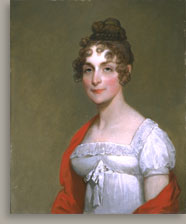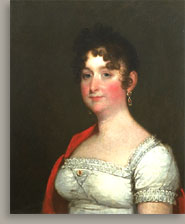 Gilbert Stuart Gilbert StuartFrancis Welch, about 1815 Description Welch wears a white neck cloth with a fanlike ruffle, knotted bow, and high collar. The folds and shadows of the neck cloth were defined with loose brushstrokes of gray paint, and the highlights, especially on the ruffle and bow, were painted with dots of opaque white. A shadow cast by his face onto the collar of his neck cloth suggests a light source in the upper right. His coat is navy blue with what appear to be brass buttons. A pentimento at the top of the coat’s left lapel suggests that the lapel’s size was reduced. The top three buttons of the coat are open, and the collar and lapels are folded down to reveal the white neck cloth. The fourth button is fastened, and another button across from it and another diagonally below it suggest a double row of buttons across the front of the coat. The top two buttons are accented with yellow opaque paint. There are creases in the coat’s fabric on the inside of the proper right arm and across the chest where the button is fastened. No hands are visible in the portrait. The background consists of an olive-colored wall that is only slightly darker in the lower right corner of the painting. The scored twill pattern in the panel is visible and runs on a diagonal. Biography Francis’s father was a Loyalist. Sometime before or after the birth of his fifth child, John Noyes Welch, on December 10, 1780, he left for Philadelphia, where he worked as a customs officer. He remained in Philadelphia until the Revolutionary War was over, at which time he left for Saint Andrews, New Brunswick, where he was awarded rations and land. He supported himself by teaching school until he departed for London in January 1788.5 Francis Welch (about 1788–90, private collection), a portrait of the senior, is characteristic of the work of James Earl and was likely painted when Welch was in London. The sitter is shown smoking a long clay pipe and wearing a green coat and yellow waistcoat with a white ruffled shirt. Francis Welch, Sr., died in London on December 7, 1790. His obituary was published in the Columbian Centinel several months later: "Died At London, Dec. 7, 1790, FRANCIS WELCH, Esq. Son of Mr. John Welch, late of this town, Comptroller of the Customs, in Cape-Breton."6 Although Francis Welch, Sr., had been appointed comptroller of the Customs on Cape Breton Island, it appears that he never arrived there.7 The Revolution often divided families, as it did the Welches. Francis’s mother apparently did not accompany her husband to London. She died in Boston on April 15, 1806.8 Francis’s paternal grandfather, John Welch (1711–1789), was a captain in the Ancient and Honourable Artillery Company as well as the militia, and he disinherited his loyalist son. John Welch was a leading Boston carver, who, among other things, supplied picture frames to John Singleton Copley.9 When Copley departed for London in 1774, John Welch purchased his property on the north east side of Green Street.10 After Boston Latin School, Francis Welch became a merchant and eventually president of the Franklin Insurance Company in Boston in 1860,11 likely having entered the insurance business by working in the office of Lemuel Pope, Jr.12 In 1819 Francis Welch served one year as a representative from Boston in the Massachusetts House of Representatives.13 Francis Welch married Margaret Crease Stackpole (1784–1830) on October 4, 1803 at the King’s Chapel, which the Stackpole family attended.14 Margaret was the daughter of William Stackpole (1746–1813), a Boston wine merchant and his wife, Ann Jackson Parker Stackpole (d. 1807).15 Margaret and Francis Welch had eleven children: Francis (b. and d. August 1804), Margaret Stackpole (1806–1886), Francis William (1808–1899), Harriet (1810–1891), Edward Minchin (1813–1831), Charles Alfred (1815–1908), Joshua Huntington (1817–1845), Theodore (1818–1819), Caroline Marie (1820–1897), John Holker (1822–1904), and Benjamin Wisner (1823–1825).16 Margaret Crease Stackpole’s membership at the Old South Church is recorded in 1809.17 Although Francis Welch was not a member of the church, he was a pew holder and an active participant in church affairs from 1811 until 1845, attending meetings and serving on church committees.18 Francis’s wife died in Boston on May 2, 1830.19 He survived her by thirty-seven years, dying at his home at Louisburg Square on April 27, 1867.20 Several days after his death the Boston Daily Evening Transcript published a lengthy tribute:
He left a will that was written on January 22, 1866. He divided his estate among his six surviving children, with the exception of his son John Holker (later changed to Edward Holker), a priest in the Society of Jesus, whose share was to remain in trust.22 Analysis The Welch portraits were also framed identically. According to family tradition, the frames were carved by John Doggett (1780–1857), a Boston carver, gilder, cabinetmaker, and framemaker, as well as a picture dealer.23 Margaret Welch’s sister, brother-in-law, and brother also sat for Stuart in Boston. It appears that Margaret’s older brother William Stackpole (1779–1822) might have been the first sibling to do so. He is likely the family member whose name appears on a surviving fragment of Stuart’s notebook from April 1808. On this page Stuart listed his activities and the names of sitters who had appointments. An X following a name likely indicates that the appointment was kept. For Wednesday, April 27, 1808, he recorded "Stackpole and Gay X."24 William Stackpole (about 1808, location unknown) is also on panel, but its dimensions are a bit larger than those of the Welches. Although William Stackpole married in 1803, there is no companion portrait of his wife.25 After Margaret’s sister Nancy (1777–1857) married her second husband, John Holker (d. 1820), in January 1815, they both sat for Stuart for companion portraits, and similarities between their portraits and the Welches’ in terms of composition and costume suggest that the Welches sat at the same time.26 The bust-length portraits of John Holker (about 1815, private collection) and Nancy Davis Stackpole Holker (Mrs. John Holker) (fig. 2) are close in size to the Welch portraits and are also on panel. Although their dresses are not identical, both Stackpole sisters wear high-waisted white dresses with low square necklines trimmed with lace. Their hairstyles are similar, and both have a red shawl partially draped over their arms and shoulders.27 After being painted by Stuart as a young man, Francis Welch sat for George Peter Alexander Healy (1813–1894) in about 1845, when he was about seventy, soon after his new daughter-in-law, Mary Love Boott Welch (1823–1899), sat. Francis’s son Charles Alfred Welch had married Boott in August 1844.28 While Healy’s Francis Welch (private collection) is a bust portrait, Mary Love Boott Welch (Mrs. Charles Alfred Welch) (1845, private collection) is a three-quarter-length view.29 2. "Christ Church, Boston Records," NEHGR 100 (July 1946): 234–235, 239; ibid., 102 (January 1948): 30; Oliver and Peabody 1982, 570. 3. Jenks 1886, 63, and Welch [1902], 25. Francis Welch, Sr., was at the Boston Latin School in 1754. See Jenks 1886, 63, and Welch [1902], 25. 4. Welch [1902], 25–26, 28. For more on Francis Welch’s involvement with the Masons, see Proceedings in Masonry 1895, 99, 113, 118–19, 121–22, 128, 144–48, 159, 194. 5. Ibid., 25. Certificate of Francis Welch’s Loss of Office in the Customhouse at Philadelphia and his conduct as Teacher in New Brunswick, May 17, 1789, Loyalist Papers, Public Record Office, London, A012/102/171. 6. Columbian Centinel (Boston), March 30, 1791. 7. There is no evidence to suggest that Welch arrived at Cape Breton. See Katie Currier, Archival Research Assistant, Beaton Institute of Cape Breton Studies, University College of Cape Breton, to Laura Mills, October 20, 1998, Worcester Art Museum curatorial files (hereafter cited as WAM files), Worcester, Mass.; Ian R. MacIntosh, Regional Librarian, Cape Breton Regional Library, to Laura Mills, October 28, 1998, WAM files; and Garry D. Shutlak, Senior Archivist, Public Archives of Nova Scotia, to Laura Mills, November 2, 1998, WAM files. 8. Welch [1902], 25. Her funeral proceeded from Francis’s house on Hawkin Street. See Columbian Centinel (Boston), April 16, 1806. For Francis Welch Sr.’s disinheritance, see Certificate of Francis Welch’s Loss of Office in the Customhouse at Philadelphia and of his conduct as Teacher in New Brunswick, May 17, 1789, Loyalist Papers, Public Record Office, London, A012/102/171. 9. For John Welch see Roberts I, 1885, 476; Heckscher and Bowman 1992,138–39; and Swan 1948, 198–99. 10. The Annie Haven Thwing Index of Early Boston Inhabitants, Massachusetts Historical Society, Boston, cites Suffolk County Deed 126.121, May 18, 1774. See also obituary for John Welch, Independent Chronicle & the Universal Advertiser, February 2, 1789. 11. Park 1926, II, 797, and Jean Lucey, Insurance Library Association of Boston, fax to Laura Mills, July 31, 2000, WAM files. 12. Thomas Lamb, Policy of Assurance, June 26, 1821, Thomas Lamb Papers, Massachusetts Historical Society, Boston, Mass., box 2. 13. Massachusetts Legislators Card File, State Library of Massachusetts, Boston, and Brenda Howitson, Chief of Special Collections, State Library of Massachusetts, to Laura Mills, October 13, 1998, WAM files. 14. Stackpole 1920, 128. 15. Lainhart 1986, 248; Stackpole 1920, 117–31; Welch [1902], 41–43; Columbian Centinel (Boston), December 4, 1813. 16. Stackpole 1920, 128–31, and Welch [1902], 29. 17. Old South 1883, 189. 18. Hill 1890, II, 355, 358, 363, 365, 373–74, 378, 385–86, 391–92, 399, 409–10, 418–20, 435–36, 447, 449, 452, 454, 462–63, 500, 505. 19. Columbian Centinel (Boston), May 8, 1830. 20. Welch [1902], 28. 21. Boston Daily Evening Transcript., April 30, 1867. 22. Will of Francis Welch, Suffolk County no. 47788. Francis changed the name of his son John Holker to Edward Holker in 1835 in memory of another sibling. Edward Holker Welch became a noted Jesuit scholar who was one of the founders of Boston College. He also taught constitutional history at Georgetown University. E. Sohier Welch to David Brigham, December 15, 1997, WAM files. Thanks to E. Sohier Welch for reading an earlier version of this biography section. 23. Holmes Hinkley Welch to Louisa Dresser, March 6, 1973, WAM files. For John Doggett see Doggett 1894, 437, 439, and Swan 1929. See also John Doggett Records, Joseph Downs Collection, Winterthur Library, Winterthur, Del., and John Doggett Day Book 1810–1811, with other accounts to 1822, on loan to the Willard House and Museum, North Grafton, Mass. 24. Swan 1938, 308. Margaret and Nancy Stackpole were both married at that date and would have been listed by their married names: Welch and Stillman. Nancy’s first husband was John Morgan Stillman. 25. For the portrait of William Stackpole see Park 1926, II, 708, cat. no. 785. According to Park, the dimensions of this portrait are 28 3/8 x 23 1/4 inches. 26. The announcement of Nancy’s second marriage to John Holker appears in the Columbian Centinel (Boston), February 1, 1815. 27. A Welch descendant wrote, "The frames are incidentally, attributed to John Doggett of Roxbury and contemporary with the portraits. You might be interested in knowing that these two portraits belong to a set of four, identically framed. The other two are of Mr. and Mrs. John Holker. He was the first French Consul in the United States and, like Francis Welch, married a daughter of William Stackpole." Holmes H. Welch to Louisa Dresser, March 6, 1973, WAM files. However, a recent comparison of the frames on the Welch portraits with the frames on Stuart’s John Holker and Nancy Davis Stackpole Holker (Mrs. John Holker) indicated that the portraits had not been framed identically. The frames on the latter pair are larger and more detailed and include alternating laurel wreaths and acanthus ornaments. For the Holker portraits see Fordney 1995, and Park 1926, I, cat. nos. 402–3, 404–5. 28. De Mare 1954, 148–49, and Welch 1907, 71. 29. According to Healy’s Reminiscences of a Portrait Painter, the artist was in Boston in September 1845. Healy 1970, 152. |

